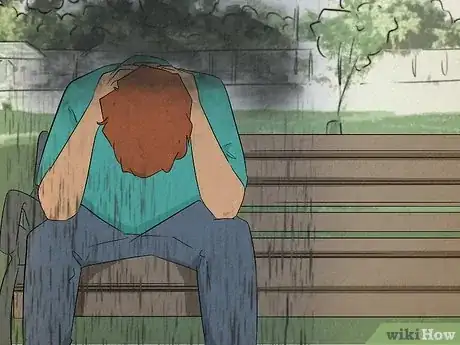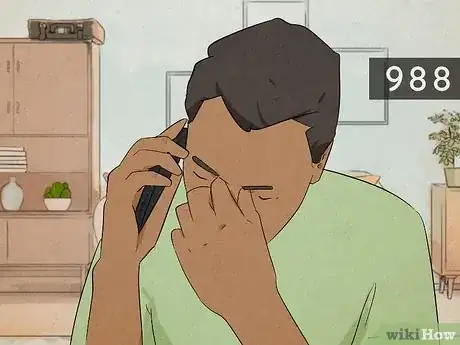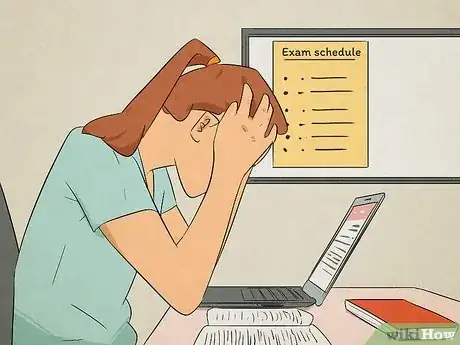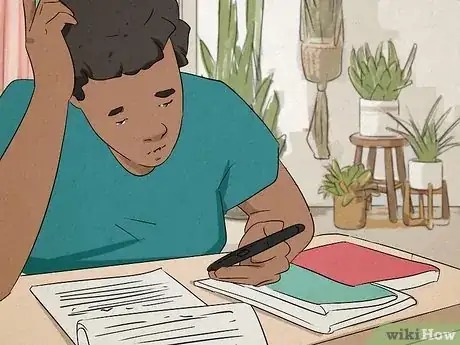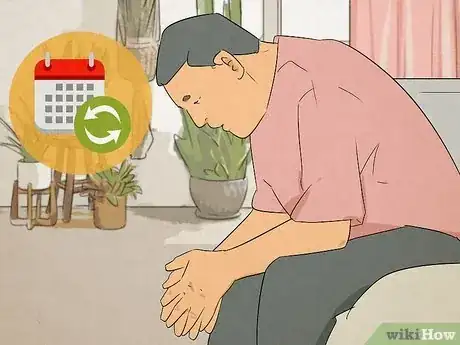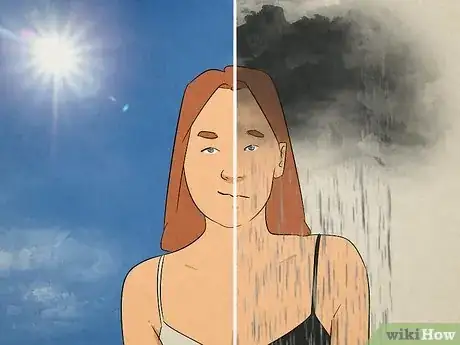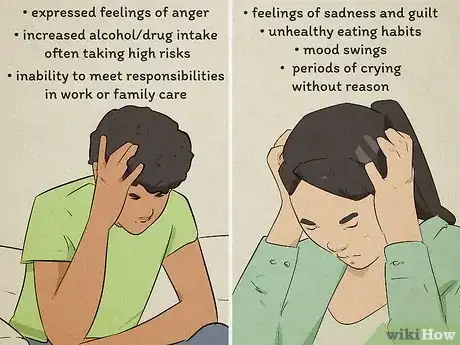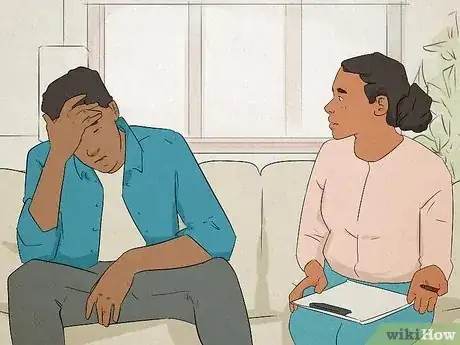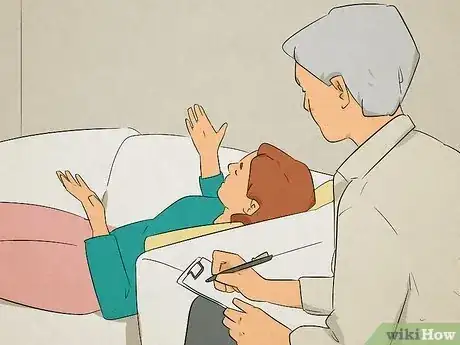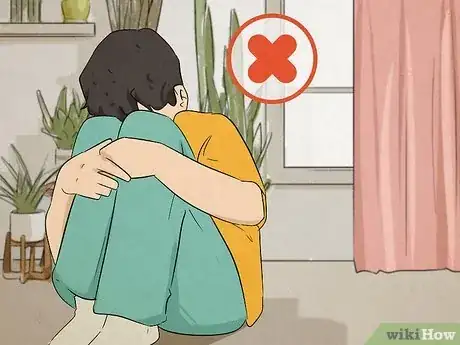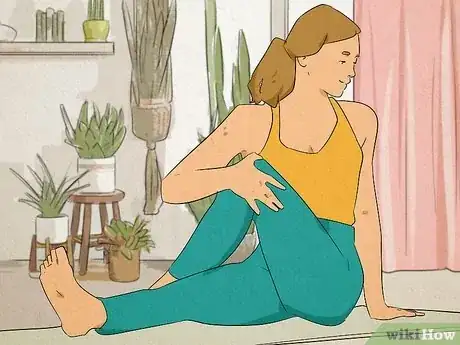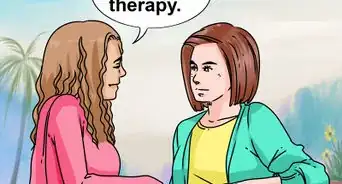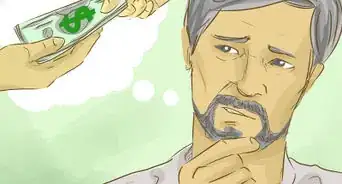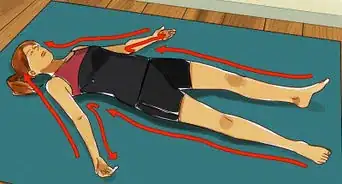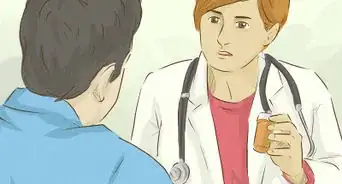This article was co-authored by Trudi Griffin, LPC, MS. Trudi Griffin is a Licensed Professional Counselor in Wisconsin specializing in Addictions and Mental Health. She provides therapy to people who struggle with addictions, mental health, and trauma in community health settings and private practice. She received her MS in Clinical Mental Health Counseling from Marquette University in 2011.
There are 14 references cited in this article, which can be found at the bottom of the page.
wikiHow marks an article as reader-approved once it receives enough positive feedback. This article has 15 testimonials from our readers, earning it our reader-approved status.
This article has been viewed 736,266 times.
Are you always feeling sad? You might be experiencing symptoms of depression. But being sad for a day or two doesn't exactly mean that you are suffering from depression. Depression is a common psychological disorder that can greatly impact daily functioning, and extends beyond feeling sad or blue. As much as people with depression want to, they can’t just “snap out of it”. With mental, emotional, and physical symptoms, it can become overwhelming very quickly. The good news is that there are ways to treat and prevent depression once you catch it.
Steps
Recognizing the Symptoms of Major Depressive Disorder
-
1Diagnose the mental/emotional symptoms. Depression manifests physically, mentally, and emotionally. Mental health professionals use a system to diagnose depression that includes experiencing a majority of the following symptoms across environments (home, school, work, social) for 2 or more weeks:[1]
- Depressed mood for most of the day (feeling sad, down)
- Feeling hopeless or helpless (nothing you can do will make things better)
- Loss of pleasure or interest in most activities (things that used to be enjoyable no longer are)
- Problems concentrating (at home, work, or school; easy tasks are now difficult)
- Feelings of guilt (feeling like you messed up and can never recover)
- Feelings of worthlessness (nothing you do seems to matter)
- Thoughts of death or taking your life
-
2Identify any suicidal thoughts. Although suicidal thoughts are not necessary for a diagnosis of depression, they can be a symptom of the disorder.[2] If you experience thoughts of suicide or wanting to take your life, do not wait. Reach out to a friend or family member for help or seek professional help.
- If you are in danger of taking your life, call emergency services.
- You may go directly to the Emergency Department at your local hospital. Mental health professionals will work with you to create a plan to talk yourself down and also help you find ways to cope with thoughts of suicide.
- If you have a therapist, let your therapist know you are having thoughts of suicide.
- If you're in the United States, you can contact the 988 Suicide and Crisis Lifeline, which is available 24 hours each day, 7 days a week by calling or texting 988. Operators are trained to talk about ways to back down from dying by suicide.
Advertisement -
3Diagnose the physical symptoms. Depression results in a number of changes to your body and behavior. When diagnosing depression, mental health professionals look at physical symptoms to help guide diagnosis. Much like emotional/mental symptoms, a diagnosis of depression most often includes experiencing the majority of the following symptoms for 2 or more weeks:[3]
- Changes in sleeping (excessive sleeping or not sleeping enough)
- Changes in eating (overeating or loss of appetite)
- Slowing of motions (feeling like movement takes all of your energy)
- Loss of energy, fatigue (no energy for daily tasks, not being able to get out of bed)
-
4Reflect on any recent or prolonged stressful events. Recent stressful events can trigger the onset of depression. Even positive events can trigger depression, such as moving, starting a new job, getting married, or having a baby. Your body and your mind take time to adjust to new experiences, and sometimes recent changes can trigger a depressive episode. If you’ve endured a traumatic event (such as loss of a child or living through a natural disaster), depression can result. Prolonged negative experiences can also lead to depression, such as enduring childhood or adult physical, emotional, or sexual abuse.[4]
- Substance use can trigger depression, particularly alcoholism.
- Health problems can also trigger depression, such as receiving a major diagnosis or coping with health difficulties.
- Just because you’ve experienced a stressful event does not mean you will develop depression. It can trigger a depressive episode, but nothing can force you to experience depression.
-
5Examine your personal history. If you’ve struggled with symptoms of depression, you may be at higher risk for experiencing depression again. About 50% of people who experience a depressive episode will experience depression again in their lifetime.[5] Examine your previous experiences and note any prolonged periods of time that you experienced symptoms of depression.
-
6Examine your family history. Notice any links to depression in your immediate family (brothers, sisters, parents). Then examine your extended family (aunts, uncles, cousins, grandparents) and notice any symptoms of depression. Note if anyone in your family has died by suicide or struggled with mental health problems. Depression tends to run in families and has a strong genetic component. If you notice a strong occurrence within your family of depression, it can put you at higher risk.[6]
- It’s important to realize that every family has links to mental health problems. Just because you have an aunt or parent who struggles with mental health does not mean you will develop a depression or another mental health issue.
Understanding Different Types of Depression
-
1Observe symptoms of seasonal affective disorder (SAD). You may feel happy and carefree during the summer, but then feel a cloud of sadness during the cold and dark winter. Aptly named SAD can begin to occur when days become shorter and when sunlight is less readily available. Symptoms of SAD can vary, but generally are similar to symptoms of Major Depressive Disorder and differ based on geographical location.[7] Locations that receive very little sunlight for a period of time (such as Alaska, USA) have a higher rate of the population with SAD.
- If you experience SAD, take advantage of any sunlight when available. Get up early in the morning and go for a walk, or take a quick lunch break to spend more time outside midday.
- SAD may be effectively treated with light therapy, but nearly half of those with SAD do not get better with light therapy alone. For more information on light therapy, check out How to Choose a Light Therapy Box.
-
2Understand differences in teen depression. Teens experience depression in different ways than adults. Teens may appear more irritable, grumpy, or hostile when experiencing depression. Complaints of unexplained aches and pains may also indicate depression in teens.[8]
- Sudden bursts of anger and increased sensitivity to criticism can also indicate depression.
- Dropping grades, withdrawal from friends, alcohol or drug use and daily isolation can also indicate problems with depression in teens.[9]
-
3Examine symptoms of postpartum depression. Giving birth is a magical time that leads to creating a family and having a child. For some women, however, the stage after giving birth is anything but jolly and gleeful. The hormonal changes, physical changes, and new role of caring for a newborn can become overwhelming. About 10 to 15% of women experience postpartum depression after birth.[10] For some women, postpartum depression sets in soon after birth, while for others, onset occurs within the first few months, and gradually becoming more pronounced.[11] In addition to symptoms of depression described above, additional signs of postpartum depression include:[12]
- Lack of interest in your baby
- Negative feelings toward your baby
- Worrying about hurting your baby
- Lack of concern for yourself
-
4Understand persistent depressive disorder. This type of depression is typically less severe than Major Depressive Disorder, yet persists for a longer duration of time. People with persistent depressive disorder typically exhibit depressed mood lasting 2 or more years. Episodes of major depression may occur within the time frame, but depressed mood persists throughout the entire duration of two years.[13]
-
5Recognize symptoms of psychotic depression. This type of depression occurs when a person experiences severe depression in addition to psychosis. Psychosis can include having false beliefs (such as believing you are the president or a spy), delusions (a distance with accepted reality, such as believing that you are being watched), or having hallucinations (hearing or seeing things that others do not experience).[14]
- Psychotic depression can be dangerous and can result in death because of the distancing from reality. Seek help immediately by contacting a friend, or calling emergency services.
-
6Recognize symptoms of bipolar disorder. Bipolar disorder is characterized by cycling mood changes. A person may experience extreme lows (severe depression) and then experience extreme highs (mania). Bipolar disorder drastically shifts an individual’s mood, behavior, and thinking. When experiencing mania, an individual may behave in uncharacteristic ways, such as suddenly quitting a job, making several large purchases, or working on projects for days with barely any sleep. Depressive episodes tend to be severe, such as having an inability to get out of bed, hold a job, or perform basic daily functions.[15] If you experience symptoms of bipolar disorder, seek professional help. It is highly unlikely that symptoms will cease without intervention. Some symptoms of mania can include:[16]
- Feeling unusually optimistic
- Feeling extremely irritable
- Feeling highly energetic despite very little sleep
- Racing thoughts
- Rapidly paced talking
- Impaired judgment, impulsivity
- Delusions or hallucinations
- For more information on bipolar disorder, check out How to Know if You Have Bipolar Disorder.
-
7Know that there are differences in depression based on gender. Males and females can sometimes experience different depression symptoms. For example, males are more likely to express anger, while females more frequently express sadness when depressed. Being aware of this can help you to better understand what symptoms you are experiencing.
- Common symptoms in males include expressed feelings of anger, increased alcohol/drug intake, often taking high risks, and inability to meet responsibilities in work or family care.[17]
- Common symptoms in females include demonstrating feelings of sadness and guilt, unhealthy eating habits, mood swings, and periods of crying without reason.[18]
Coping With Depression
-
1Seek out a mental health professional. If you are in any way unsure of your emotional state or are struggling to stay afloat amidst a depressive episode, seek therapy. A therapist can help you to understand your depression and help you find ways to cope and prevent future depressive episodes.Therapy is a highly effective treatment for depression, as it helps you to explore possible causes, overcome your negative feelings, and begin to feel and behave normally again.[19]
- Cognitive-behavior therapy (CBT) is highly effective at treating depression. It helps you confront your negative thoughts and thought patterns into more positive patterns. You can learn to re-interpret your environment and your interactions in a more supportive way.[20]
-
2Consider consulting with a psychiatrist. For some, therapy coupled with medication can be helpful in treating symptoms of depression. Recognize that medication is not a cure-all and comes with risks.[21] Seek out your medical provider or a psychiatrist to learn more about antidepressant medication.
- Discuss possible side effects with your prescriber and learn the risks of going on medication.
- If you experience an increase in suicidality due to medication, speak to your prescriber immediately.
- If you begin taking medication for your depression, do not stop taking it immediately upon seeing results. Use as directed by your prescriber.
-
3Avoid isolating yourself. It’s important to feel loved and supported, but it is especially important if you struggle with depression. It can be easy to disengage from friends and family when you feel depressed, but spending time with friends can boost your mood. When deep in depression, make time for your friends, even if your body or mind wildly protest.[22]
- You can also join a support group. Check out the National Alliance on Mental Illness (NAMI) at https://www.nami.org/ to connect to information about depression and how to find a support group.
-
4Engage in exercise. The benefits of exercise for treating depression are strongly supported by a growing body of research. Some studies show that exercise alone can help alleviate symptoms of depression and prevent onset for the future. It can be difficult to motivate yourself to go to the gym or go for a walk-- especially when depression seems to drain all of your energy-- but find some motivation and get some exercise.[23]
- Exercise can be as simple as walking 20-40 minutes each day. If you have a dog, commit to walking your dog each day for double the happiness boost.
- If you struggle to find motivation to be active, remind yourself that once you get moving, you will not regret putting in the effort. It’s rare for somebody to leave the gym thinking “I totally wasted my time, I should not have gone.”
- Get a workout buddy to help your motivation. Having some accountability can help you get to the gym.
-
5Manage your stress. Managing stress is one way to cope and prevent depression. Make a daily practice to do something that relaxes you (no, social media does not count). Try yoga, meditation, tai chi, or muscle relaxation techniques. You can also begin journaling or putting to use some creativity to draw, paint, or sew.[24]
- For more information, check out Reduce Stress.
Warnings
- Substance abuse may seem to provide immediate relief from depression symptoms, but can worsen the illness over time. If you begin to misuse drugs or alcohol to deal with your depression, stop immediately and talk to your mental health professional about alternative treatments.⧼thumbs_response⧽
References
- ↑ http://www.ncbi.nlm.nih.gov/books/NBK64063/
- ↑ http://www.ncbi.nlm.nih.gov/books/NBK64063/
- ↑ http://www.ncbi.nlm.nih.gov/books/NBK64063/
- ↑ http://www.helpguide.org/articles/depression/depression-signs-and-symptoms.htm
- ↑ http://www.ncbi.nlm.nih.gov/pmc/articles/PMC2169519/
- ↑ https://www.nimh.nih.gov/health/topics/depression/index.shtml#part_145395
- ↑ http://www.helpguide.org/articles/depression/seasonal-affective-disorder-sad.htm
- ↑ http://www.helpguide.org/articles/depression/depression-signs-and-symptoms.htm
- ↑ https://www.nlm.nih.gov/medlineplus/ency/patientinstructions/000648.htm
- ↑ https://www.nimh.nih.gov/health/topics/depression/index.shtml
- ↑ http://www.helpguide.org/articles/depression/postpartum-depression-and-the-baby-blues.htm
- ↑ http://www.helpguide.org/articles/depression/postpartum-depression-and-the-baby-blues.htm
- ↑ https://www.nimh.nih.gov/health/topics/depression/index.shtml
- ↑ https://www.nimh.nih.gov/health/topics/depression/index.shtml
- ↑ http://www.helpguide.org/articles/bipolar-disorder/bipolar-disorder-signs-and-symptoms.htm
- ↑ http://www.helpguide.org/articles/bipolar-disorder/bipolar-disorder-signs-and-symptoms.htm
- ↑ https://www.nimh.nih.gov/health/publications/men-and-depression/index.shtml
- ↑ https://www.healthline.com/health/depression/symptoms-of-depression-in-women#male-vs-femaledepression
- ↑ https://www.nimh.nih.gov/health/topics/psychotherapies/index.shtml
- ↑ https://www.nimh.nih.gov/health/topics/psychotherapies/index.shtml
- ↑ http://www.helpguide.org/articles/depression/depression-signs-and-symptoms.htm
- ↑ http://www.mayoclinic.org/diseases-conditions/depression/basics/coping-support/con-20032977
- ↑ http://www.ncbi.nlm.nih.gov/pmc/articles/PMC474733/
- ↑ http://www.mayoclinic.org/diseases-conditions/depression/basics/coping-support/con-20032977
About This Article
You may be depressed if you feel hopeless, experience a loss of pleasure in most activities, have problems concentrating, or feel guilt. In addition to these emotional signs, watch for physical symptoms, such as changes in sleeping and eating patterns and loss of energy. If you experience thoughts of suicide, reach out to a friend or family member for help or seek professional help immediately. You can also go to the Emergency Department at your local hospital to talk to a mental health professional or call the National Suicide Prevention Lifeline, which is available 24 hours a day, at 1-800-273-8255. To learn how to cope with depression, keep reading!
